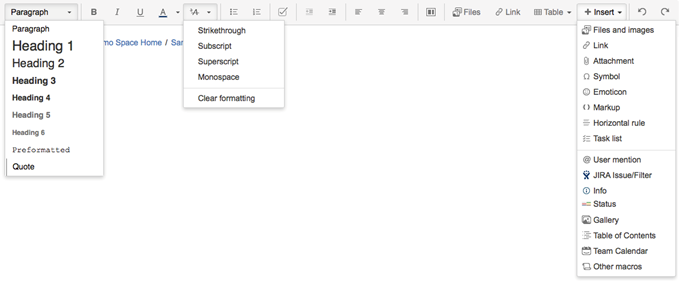Pages are the place to capture all your information. You can either choose a blank page and use it like a word processor to add rich text, tasks, images, macros and links, or use one of the useful templates to capture meeting notes, or create a blog post.
Create a page
You can create a page from anywhere in collaborate.green. Just use the create button in the top menu bar. N.B. The new page will be created as child page of the page you’re on.
You can choose between creating a blank page or creating a page from a template.
1. Create a blank page
If you want to quickly create a blank page, hit the Create button in the header. A blank page will be created as child page of the page you are on.
2. Create page from template
If you want to create a page from a template, hit the Create from template button .
A dialogue box will open:
- Select in which space you want to create your new page.
- Select the desired template.
Once you have create a new page (whether this is a blank page or a template), the new page will open in Edit-mode (see Edit a page), where you can enter a page name.
Special characters
Do not use special characters in page or attachment names, as the page or attachment may not be found by Confluence search, and may cause some Confluence functions to behave unexpectedly.
Edit a page
To edit a page, you’ll need to enter Edit-mode (by clicking Edit in the top right corner). You can enter content as you would in a Word document, apply formatting, and embed other content and files on the page.
N.B. To edit a page, you need the 'Add Pages' permission for the space. See Permissions and restrictions. Someone may also apply page restrictions that prevent you from editing the page.
When you've added some content, you can choose Preview to take a peek at what your finished page will look like, and choose Save when you've finished your edits.
After you save you'll see the page in 'view' mode. You can re-enter the editor any time by choosing Edit.
N.B. Confluence automatically saves drafts of your page as you work. If another user begins editing the same page as you, Confluence will display a message and will try to merge the changes when you save your page. To see changes between different versions of the page, look at the history of the page.
Edit-mode allows you to enter or change the title of your page; insert content including text, images, and links; and format your content using the toolbar.
If you're renaming your page, there are some things you should take into account.
Editor toolbar
The editor toolbar is where you format your page layout and text, and add links, tables, images, attachments and macros. You can also perform a find and replace, or get help using the editor by choosing the help icon .
The Insert menu
Use the Insert menu to include any of the following content types on your page:
- An image
- A link to another page or external URL, or a link to an attachment or image
- An emoticon or symbol, or a horizontal line
- A macro (choose a specific macro, or Other Macros, from the Insert menu)
You can also use keyboard shortcuts to insert links, images, and macros. Try out the shortcuts listed below:
- Type [ (square bracket) to insert a link.
- Type ! (exclamation mark) to insert an image or other media.
- Type { (curly bracket) to insert a macro.
Typing any of the above shortcuts will trigger the autocomplete functionality, prompting you with a list of suggestions to finish off the entry. For more shortcuts, click the help icon on the editor toolbar.
Restrictions, labels, and notifications
When editing a page, you may want to set restrictions on who can view or edit the page, or add labels to the page to make it easily searchable.
Record change comments and notify watchers
When you finish editing a page, you can add a comment to let others know what you changed. Type a short message in the change comments field in the footer. The comment will be visible in the page history.
If you want to send a notification to people watching the page, select Notify watchers. The change comment will be included in the notification email. The Notify watchers checkbox remembers your last selection, so if you choose not to notify people, the checkbox will be deselected for you next time.
Things to help you work faster
Drag-and-drop for external images and files
You can drag files, like images, multimedia, Office files and PDFs, from your computer and drop them directly into the editor. The contents of the file will be embedded into the page or blog post.
Drag-and-drop within the editor
In the editor panel, you can drag an image or a macro from one location to another on the page. Hover your cursor over the image or the macro placeholder and your cursor changes to a drag-and-drop icon. Click the image or macro and drag it to a new location.
Note: For the drag-and-drop of images and macros in the editor, Confluence supports the following browsers: Chrome, Firefox, and Internet Explorer 10 (desktop mode).
Keyboard shortcuts
To view the available keyboard shortcuts, choose the help icon in the editor toolbar.
Find and replace text
Click the icon on the toolbar, or use the keyboard shortcut Ctrl+F (Windows) or Cmd+F (Mac OS).
Search matches are highlighted in yellow. You can step through the results one by one, replace the matching text strings one by one, or replace all matching strings at once. Find and replace works only within the current page.




